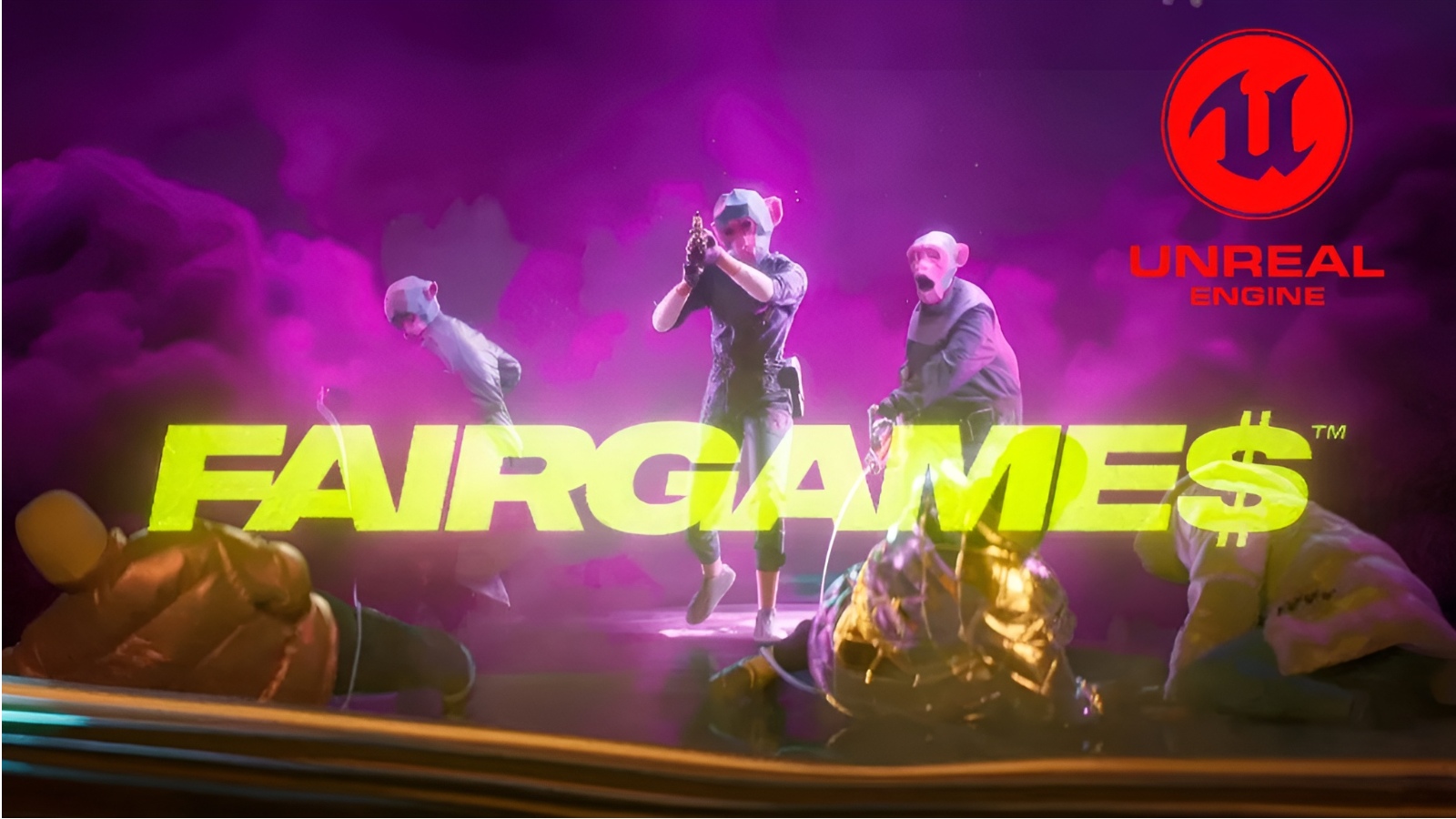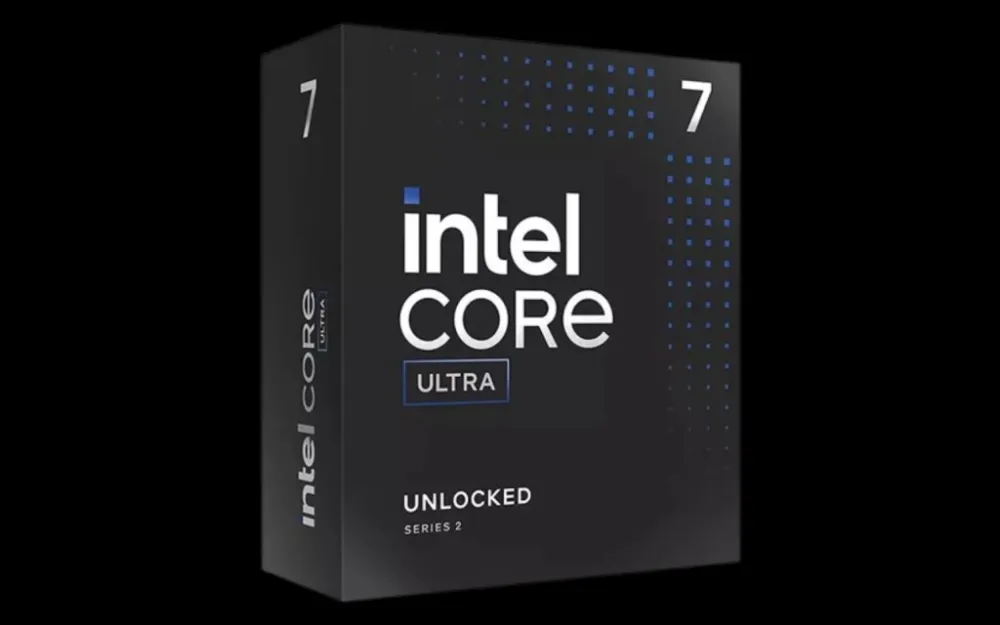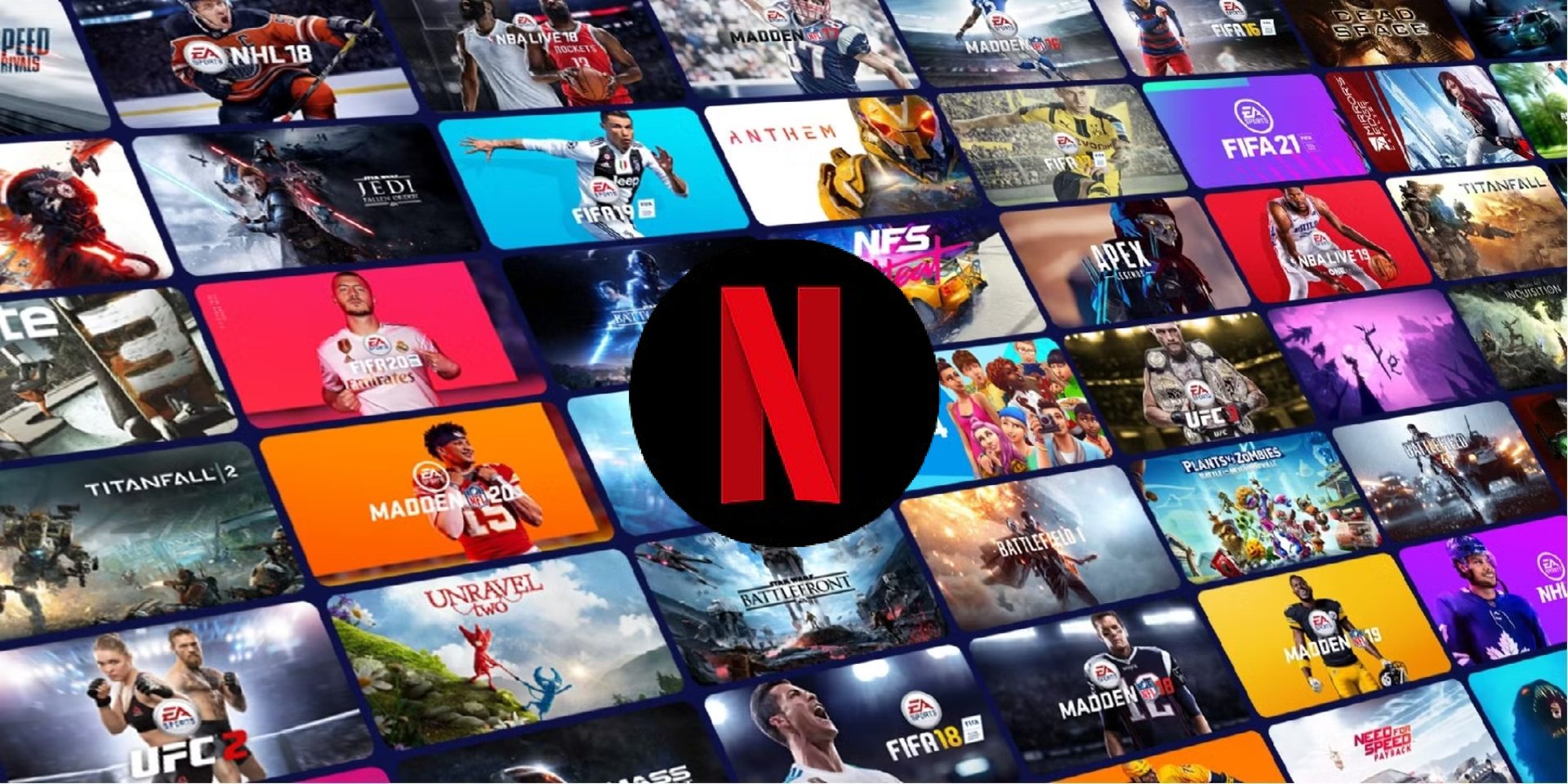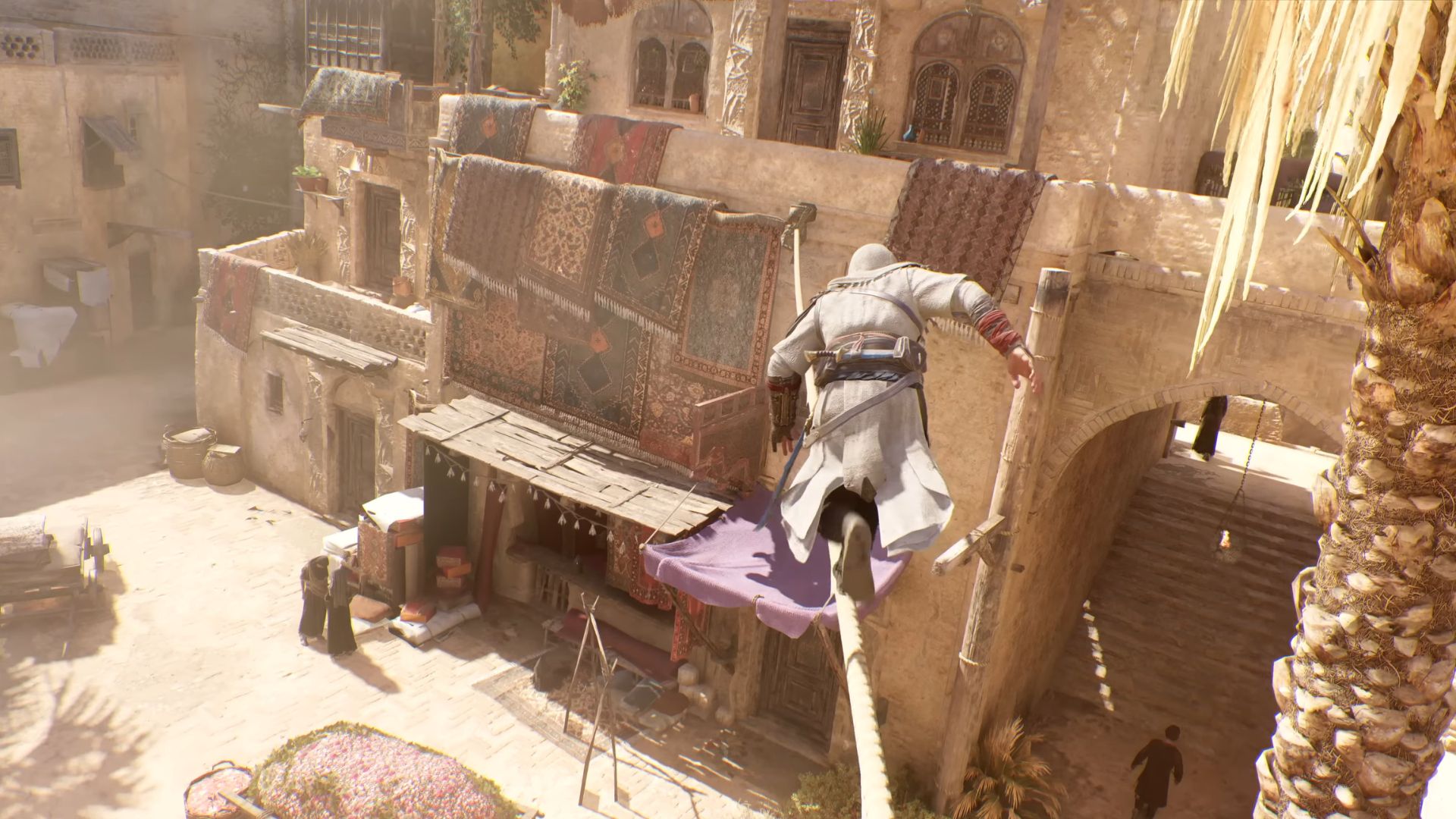AMD recently released their 50 series-family cards for their 6000 series lineups. Although they seem promising, the hype for the next-gen AMD Radeon cards is still alive. Especially with Lisa Su’s statement during the earnings report, we should be hearing news about the 7000 series cards soon.
Although, it does look like 7000 series might not be as close to release as first speculated. Lisa Su’s statement concurred that Radeon RX 7000 series cards would be arriving sometime in the 2nd half of 2022. So far, we are speculating that the family consists of RX 7700 XT, RX 7800 XT, and RX 7900 XT.
Today, let’s talk about everything we know about the RX 7800 XT so far. We can confirm, that, the RX 7800 XT utilizes TSMC’s 5nm process node. As there are rumors to support a multi-chip design, some of the parts will use a 6nm node.
The GPU’s chipset has the name, “Navi 31”. However, it is also referred to as “Navi 31 XT” and “Navi 31 XTX” as well. The core architecture has the name, “RDNA 3”, being the successor to the RDNA 2 lineup. There have been a few leaks and updates regarding Navi 32 which we will be discussing today.
Regarding 7000 series, AMD has not given many confirmations so far. However, speculations are all over the air. Therefore, we advise you guys to take everything that we discuss from here on out with a grain of salt.
We will talk about tweets from leakers who give factual information in their leaks. We will also try to explain everything that the RX 7800 XT is going to be coming with.
Radeon RX 7800 XT Architecture
There have not been a lot of leaks regarding the RX 7800 XT Specs or 7900 XT graphics cards as of right now. A few speculations have been going around the rumor mills, however.
What we know for sure is that the 7800 XT and 7900 XT GPUs are based on Navi 31 architecture. This architecture is the successor to the Navi 21 architecture found in the RX 6900 XT graphics cards.
Speaking of Navi 21, leaks regarding the 7000 series are going haywire. To the point that they’re saying the Navi 33 will give more performance than the RX 6900 XT. This is what Twitter leaker @KittyYYuko has to say about Navi 33:
Navi 33 (?) = Navi 21 + Next Gen IP Core
— Elysian Realm (@KittyYYuko) May 2, 2021
We speculate the Navi 33 to be the RX 7600 XT. This consumer-grade graphics card will have the performance of the Navi 21 (6900 XT) with additional performance over that. So, you’re going to see a next-generation IP Core uplift as well.
This leak does, somewhat, match with what AMD executives have been saying for quite some time now. There have been reports that RDNA 3 architecture will topple over RDNA 2. The RX 7600 XT is going to be faster than the fastest RDNA 2 GPU, the 6900 XT.
Now, just imagine how fast the RX 7800 XT must be, if this rumor ends up being true. Therefore, let’s look at a few specifications regarding the Navi 31 that we have found out in May, 2022.
3D Stacked Dies
If this turns out to be true, Navi 31 is going to be a game-changer for AMD. 3D stacking is a concept that has been going around in the tech world for nearly a decade now. It started with Intel teasing that their processors would soon be 3D stacked. This later became a reality for AMD’s Ryzen 7 5800X3D; the latest processor that AMD released. Now, there have been speculations that Navi 31, at least, can come equipped with this 3D stacking as well.
So, what you’re going to see, is that the 5nm node will be 3D stacked. Alongside that, the 6nm will be an I/O Infinity Cache die. This will allow AMD to vertically stack their chips in the future. Therefore, even though RDNA 3 lacks performance, AMD is looking to completely topple over NVIDIA in the next few years.
What, in actuality, is 3D stacking? Well, 3D stacking, or 3D V-Cache, is simply a chip connection technology. You can stack two or more chips vertically without the usage of any wires using this technology. Using the L3 Cache within the 3D V-Cache chip, games get the significantly lower latency.
This improves overall FPS in games which is why the 5800X3D is so remarkable. If you want to learn more about 3D V-Cache then here’s an informational video by AMD. The video explains what the technology is and how it is optimizable in the future.
Stream Processors (SPs)
Up until March 2022, rumors kept floating around that the Navi 31 will have 15,360 Stream Processors (SPs). This leak first came from famous Twitter leaker @greymon55 in December 2021. This is what he said back then:
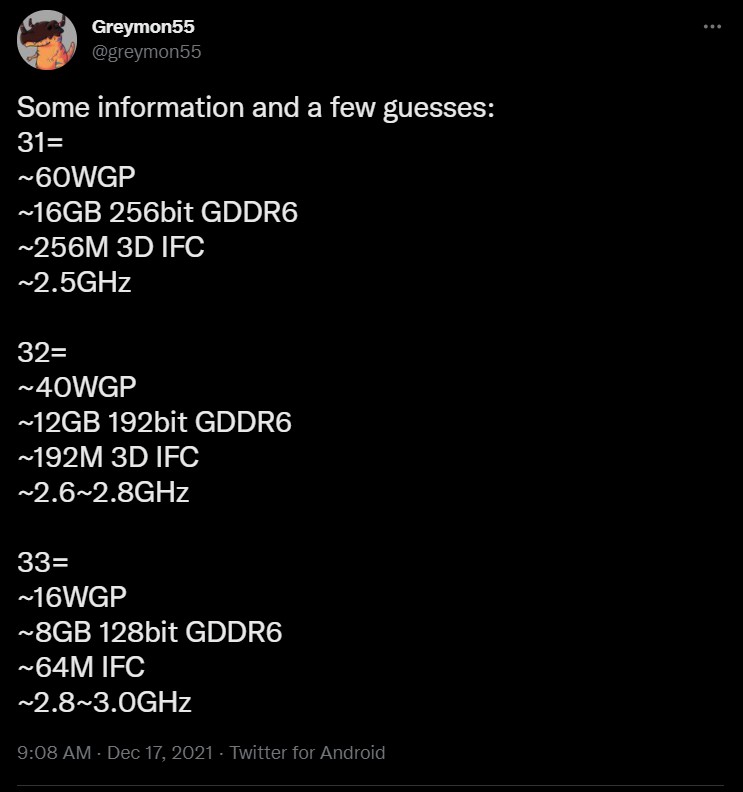
According to greymon55, Navi 31 was going to get 60 Work Group Processors (WGPs). The Navi 31 GPU features two Graphics Core Dies (GCDs) and a single Multi-Cache Die (MCD). Each GCD has a total of three Shader Engines (SEs) to make up for a total of six. Whilst each Shader Engine has 2 Shader Arrays to constitute a total of 12.
Now, each Shader Array has 5 WGPs to come up with 60 in total. Each WGP comes with 8 SIMD32 units with 32 Arithmetic Logic Units (ALUs), making up 480 in total. These SIMD32 units, when combined, form 7,680 cores per GCD, making for a total of 15,360 SPs.
Sadly, this rumor has come to a close since then as greymon55 has come up with a new SP count. These are the latest SP numbers that have come up:
12288
8192
4096
🤔— Greymon55 (@greymon55) May 2, 2022
12,288 are the Stream Processors for the Navi 31. That makes 48 WGPs and 96 Compute Units (CUs). Yes, they have gotten lesser in numbers. However, that doesn’t truly compromise performance! According to Youtuber iVadim, AMD is going for the same performance target by achieving a GPU clock speed of ~3GHZ!
GPU Memory
There haven’t been many speculations regarding the GPU memory in the RX 7800 XT. Greymon55 leaked that Navi 31 would have ~256 MB infinity cache. This still seems to be the case if we take the 3D V-Cache into account; this amount doubles, at most.
That is the number that iVadim has come up with. An approximate of 256-512 MB of Infinity Cache is expected in the Navi 31 GPUs. This is a significant increment from the RX 6900 XT, which has an infinity cache of 128 MB.
So, we can expect an increment of 2-4 times more than that of the RDNA 2 flagship graphics card.
iVadim also speculates that we can see 16+ GB of GDDR6 VRAM in the Navi 31 GPU. The VRAM will be faster than the RX 6900 XT, which stands at 16 Gbps. Navi 31’s memory speed, as speculated by iVadim, is going to be anywhere from 16 Gbps to 20 Gbps.
Power Draw
AMD has always been secretive with all of their graphics card releases. Almost until the last moment, we are never sure of what to expect from their next-generation products.
Looking at the power draw required by the RTX 4080, it is imminent that AMD will be competitive about it. Famous Youtuber and leaker, Moore’s Law is Dead has a similar opinion.
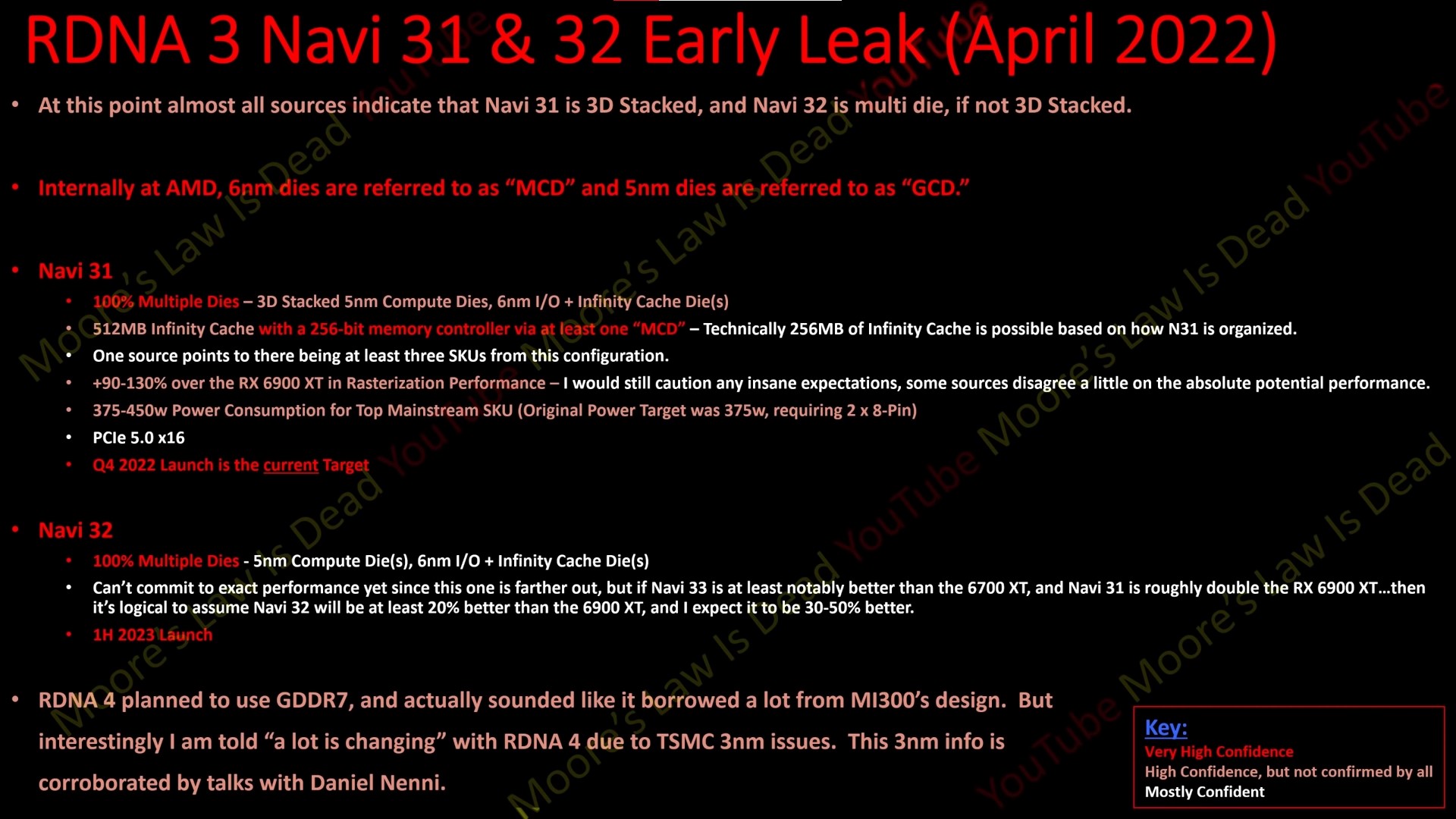
Moore’s Law is highly confident that the power consumption required by Navi 31 will be anywhere from 375w to 450w.
Seeing how the RTX 4080 goes at the farther end of this speculation, we should see AMD try to keep the wattage low.
However, if the RX 7800 XT does come up with 450w, you’ll require a power supply with about 1000 watts of power or more. It will still require the same 2 x 8-pin connector that modern GPUs use these days.
There are also speculations of PCIe 5.0 lanes being incorporated in Navi 31 GPUs. Although, we’re not sure whether that will happen or not. It will be a complete treat if it does happen, however.
RX 7800 XT Launch Date
AMD’s CEO Lisa Su gave a statement in January that RDNA 3 will launch in the 2nd half of 2022. However, AMD seems to have changed their agenda a little bit.
By “2nd half” AMD did not mean July but rather quarter four of 2022. Greymon55 stated in February that he was no longer sure of the release date of RDNA 3.
I'm no longer sure of the release date for RDNA3, and a lot of the earlier information doesn't apply anymore.
— Greymon55 (@greymon55) February 11, 2022
This has been the last of what we have heard from greymon55 regarding RDNA 3. However, Moore’s Law is Dead has confirmed that Navi 31 and Navi 33 will launch in Q4 2022. Navi 32, on the other hand, will launch in Q1 2023.
So we can expect to see the RX 7900 XT, RX 7800 XT, and the RX 7600 XT out in the market by Christmas this year. The 7700 XT should be out by March of the next year at most.
RX 7800 XT Pricing
There aren’t many sources that have said anything about Navi 31 graphics cards or RX 7800 XT Price. NVIDIA is going to be going all out because customers are buying products even at twice the price. AMD is going to be following a similar route this time as well because they have seen how customers have the buying power.
Twitter user @shmitapz has drawn a chart with possible pricings for all the upcoming graphics cards:
I have a dream.
But i fear the 7800XT would be more expensive than a 4080 and i don't even want to start on the whole 4050 vs 7600(XT) thing. pic.twitter.com/JOlstatDEp
— Shmitapz (@shmitapz) March 25, 2022
The RX 7800 XT is priced at $999 so far. We’re seeing a GPU that can give ~+130% rasterization performance than the 6900XT being sold off at the same price. And it’s still cheaper than the RTX 4080, its competitor.
Of course, take these numbers with a hefty grain of salt. As of now, we cannot comment on what the actual pricing of any of these GPUs is going to be.
Whether it be $999 or $699, finding these graphics cards at their MSRP will be the real challenge. For customers and manufacturers, both.
With how the market is going these days, it’s safe to assume that availability will reach normalcy soon. Therefore, there shouldn’t be much to worry about whether Navi 31 GPUs will be available or not.
RX 7800 XT Specfications
Through everything that has been discussed thus far let’s look at what the specifications for the RX 7800 XT are. Mind you, all of this information is coming from leaks and almost none of it is official.
Therefore, we advise that you take the following chart with that in mind and not jump the gun just yet.
| Stream Processors | 12,288 |
|---|---|
| Total Compute Units | 96 |
| Total Shader Arrays | 12 |
| Total Shader Engines | 6 |
| Total Work Group Processors | 60 |
| Cores per Graphics Core Die | 7,680 |
| Multi Cache Die | 1 |
| Bus Width | 384-Bit |
| Infinity Cache | 256 MB – 512 MB |
| Memory (Memory Type) | 16 GB – 20+ GB (GDDR6) |
| PCIe Lanes | Gen 5.0 x 16 |
| TDP | 375w-450w |
| Launch Date | Q4 2022 ~November 2022 |
| Launch Price | ~$699-$999 |
RX 7800 XT Performance
We’re currently too far away from the actual release date to come up with any actual performance charts. However, Moore’s Law is Dead has broken most of the rumor mills going around.
He states that the Navi 33 RX 7600 XT is going to be more powerful than the RX 6900 XT. He, then, states that Navi 31 GPUs will be anywhere from 90-130% faster in rasterization performance against the 6900 XT. So,
it’s safe to assume that the RX 7800 XT falls in the 90-100% category while the higher spectrum is for the 7900 XT.
Even so, this much performance in a single generation uplift is amazing. AMD has always baffled us with its generational gaps, so we can expect something similar for this generation too.
June Update
During the past 2 weeks we have seen AMD tease their Ryzen 7000 series processors. However, nothing has been stated in regards to the 7000 series graphics cards. Even so, there have been a few rumors for the RX 7800 XT that were not too apparent before.
For example, the RX 7800 XT and RX 7900 XT will come with DisplayPort 2.0. This is the first time we are going to see a consumer grade graphics card with this new port. Consequently, the DisplayPort 2.0 allows up to 16K resolution at a 60Hz frame rate. Along with that, the DisplayPort 2.0 also allows for 4K resolution at 240Hz.
Now, if a consumer grade graphics card is coming with such a port, we can assume that its performance is going to be on par as well. Although, there have been no new updates regarding the performance of the RX 7800 XT.
Lastly, the release date for the Navi 31 graphics card is currently up for Q4 of 2022. Whether this date will change or not can’t be speculated as of yet. In retrospect, we can assume that the date can be shifted to September 2022 to counter NVIDIA’s launch.
FAQs
So far, all dates and chances point for the Navi 31 and Navi 33 graphics cards to drop by Q4 2022. So, expect anywhere between October to December. Navi 31 consists of RX 7900 XT and RX 7800 XT. Whilst, the Navi 33 consists of RX 7600 XT. Navi 32; RX 7700 XT will drop by Q1 2023.
Current leaks state that Navi 33, the weakest of the bunch, is going to be more powerful than the 6900 XT. The 7800 XT is speculated to have a 90-100% greater rasterization performance than the 6900 XT. So, in short, yes. The 7800 XT is definitely going to be better than the 6800 XT.
To support the RX 7800 XT, which has a Thermal Design Power (TDP) of 450w, you will need a good power supply. We suggest going at least 1000 watts or above. This is going to be helpful if you decide to buy the RX 7900 XT later. Therefore, going with gold or platinum-rated 1000-watt power supply will serve you well.
3D V-Cache technology allows a component to having more L3 Cache with a shorter distance. Short distance means lower latency which will in turn make your games run faster. We have explained this process in slight detail in the article, so you can take a look at that for more information.
Thank you! Please share your positive feedback. 🔋
How could we improve this post? Please Help us. 😔
[Comparisons Expert]
Abdemanaf is a skilled creative writer who has been honing his craft since 2011. While initially working in different fields, he found a passion for technology and has been exploring the tech world since early 2015. Over the years, he has developed an in-depth knowledge of the latest tech trends and product offerings by various companies.
Abdemanaf’s writing reflects his analytical mindset and ability to think critically. He has a knack for breaking down complex technical information into easily digestible pieces, making his articles engaging and accessible to readers from all backgrounds. In February 2022, he joined Tech4Gamers as a blog and product comparison writer, where he has been able to hone his skills further.
As a writer, Abdemanaf is dedicated to staying up-to-date with the latest technological advancements and trends, enabling him to provide readers with the most relevant and accurate information. He is always eager to learn more and is constantly seeking new challenges to improve his skills.
Get In Touch: manaf@tech4gamers.com


